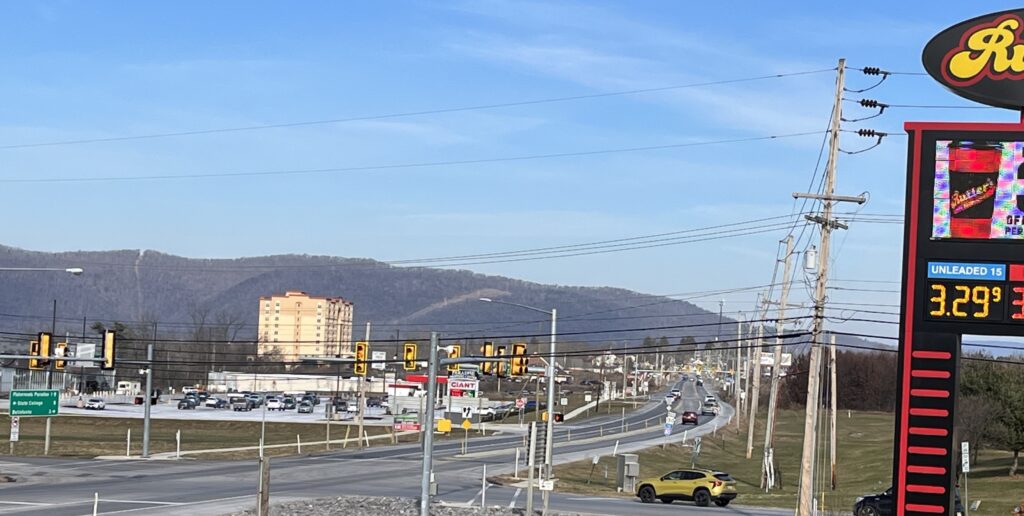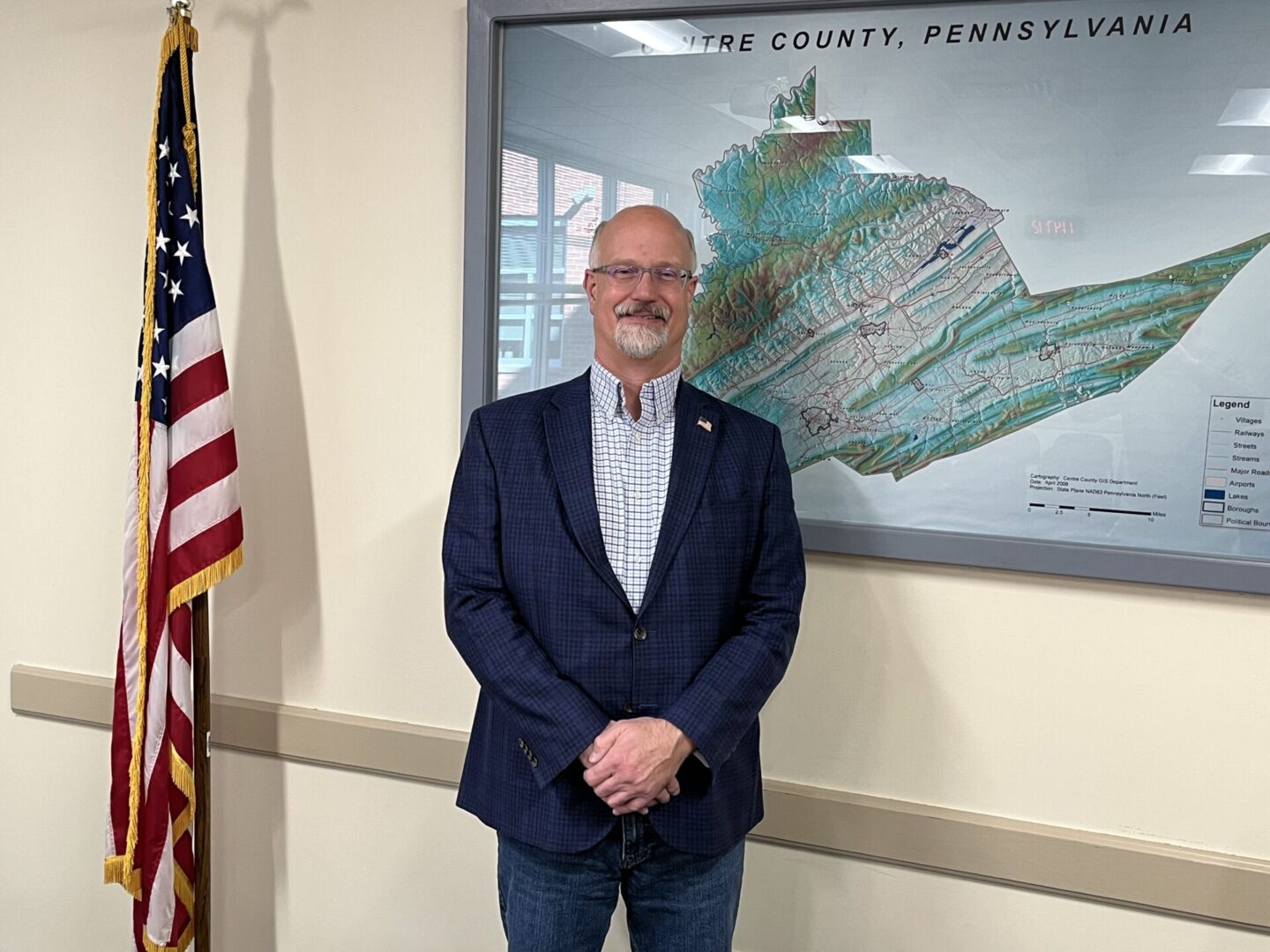Mark Higgins might be the least surprised person in Centre County about the development boom along the Benner Pike on the way to Bellefonte.
“I was telling people seven or nine years ago, Bellefonte is the next hotspot,” says Higgins, who is now chairman of the Centre County Board of Commissioners. “And virtually everybody said I was crazy.”
Downtown Bellefonte’s renaissance over the past several years has been well chronicled. Increasingly—from planned hotels to a supermarket to convenience stores and fast-food eateries, to a massive proposed warehouse that could bring 700 jobs—that economic resurgence is spreading to the Benner Pike corridor.
Higgins says he’s also seeing signs of an economic rebirth in Philipsburg.
“They’re doing it their own way; it’s the Philipsburg way, but to me, it’s starting to feel a lot like Bellefonte felt seven years ago,” he says, noting the opening of numerous new businesses and a small uptick in the number of residents at a time when most rural communities are losing population.
Another encouraging economic sign for the county, Higgins says, is that there is more for young professionals to do.
“When I was taking office [in 2016], I heard lots and lots of relatively valid complaints from young professionals saying, ‘Once we’re old enough that we’re really not into the college scene anymore, there’s not a whole lot of places for us to hang out.’ Well, now, just on Route 45, you’ve got Pine Grove Hall in Pine Grove Mills, Ferguson Township, a New York City-quality venue. And then you have J&L Cidery, which is very popular with the younger end of the college professionals. When I go there, I raise the average age. And then you go to University Wine Company just down the road. Maybe it’s a little more toward the older end of young professionals, but still a great place to hang out. … We didn’t used to have all of that, right on the same highway. And you keep going, you’ve got all the great things in Boalsburg. And eventually you end up in Millheim at the Elk Creek Cafe.”
Here’s more from our conversation on development, which took place in mid-November.
Why is the Bellefonte area in particular booming?
Higgins: First of all, Bellefonte has the infrastructure in place to handle it. The power lines, the water lines, the sewer lines, the natural gas lines. When you’re paving over farmland, which the commissioners are not generally in favor of, not only are you taking highly productive soils out of making food, which we all need, it’s also incredibly expensive, because you’re not running 100-foot sewer lateral; you’re running a mile of sewer pipe, before we even get to the first lateral. Same thing with the electric. You’re not just running one line to a couple of new homes. You’re putting in a whole substation, and then multiple transformers. And the same thing with natural gas.
Whereas we can house the same number of people in areas that already have this infrastructure in place; it keeps the costs down, makes it faster. And Bellefonte’s a great place. It’s got a vibrant downtown again. Bellefonte is cool. Bellefonte is where the adults go now to have fun.
Is there anything in that pace of growth that concerns you?
Higgins: Not necessarily. People talk about the growth in Bellefonte and State College. … We see eight percent growth now in a decade. So, it’s manageable. It’s reasonable. I’m hoping it can mostly be infill-type development, or if we are eventually having to pave over one of our over 1,000 farms in the county, it’s a farm that maybe had poor quality soils, that is under heavy development pressure anyway. And hopefully, we develop it relatively densely.
We’ve got a lot of homes that are put on, say, six acres. I’ll try to make the math easy for myself here. We’ve got a 180-acre farm; we could put thirty dwellings on it or we could put a couple thousand. And when possible, I’d like to put the couple thousand because the county’s housing study that we just finished last year showed that, everything else being equal, we have enough large apartment buildings to serve the county’s needs now. We now have vacant apartments, which we’ve never really had in decades in Centre County. And we also have a whole lot of single-family homes available. What we’re missing is what they call the middle, which is the tiny homes, the duplexes, the quadplexes, the less than twenty-unit apartment buildings, the townhomes, the condos. And as we build more of that, it’ll free up the single-family homes.
Both statistically and anecdotally, there are a lot of people who are early retired, so still really vigorous. They’re not ready to move into some sort of continuum of care community or anything. But they’re also not really into maintaining single-family homes anymore because it is a lot of work. … So, if those vigorous early retired could have places to move to, boom, we’re freeing up single-family homes.

Are you optimistic that the planned Bellefonte waterfront hotel is going to happen?
Higgins: I think eventually it will. It would be nice if it was [this] spring or something. A lot of the B&Bs in Bellefonte are full, which is great. And I believe one of the reasons why Bellefonte borough started to tighten down on some of the Airbnbs was they were also really busy, which was causing some issues. So, I really think that there is enough demand in downtown Bellefonte to support a boutique hotel.
With all this growth, is the transportation infrastructure adequate? The area I specifically wonder about is South Water Street and High Street in Bellefonte, at Talleyrand Park. Is there any way to make that traffic flow better?
Higgins: Countywide, we’re in very good shape. The commissioners worked with a broad variety of local, state, and federal elected officials and the transportation planning organization to get a high-speed interchange at I-99 and I-80. … I think once there’s a high-speed interchange there [in a few years], we’ll see even more people coming off of it to pop into Bellefonte to charge their cars, to get some food, to see the history here, to take the historic train rides.
But specifically, yes, the stretch [south of High Street] of Willowbank Street, Water Street, Phoenix Avenue is highly problematic. The angles are not good; there’s more and more traffic. Stoney Batter is a strange street. But the estimates we have had to fix the problem are in the tens of millions of dollars, more than the amount of transportation funding we receive for the entire county from the state of Pennsylvania in a single year. Unfortunately, in the short term, we’re just going to have to chip away at it. Better signage, a little better paving, maybe some work on traffic light timing, but to fix the problem, tens of millions of dollars.
Something’s going to have to be done where the rail line and the road would not be at the same level. If you bury the rail line a little bit, (that) is going to be extremely disruptive to the businesses that utilize that line. If we raise the rail line, that’s going to cause some site noise issues, probably. If we keep the rail line where it is but we raised the road, what’s that going to look like? The rail line is a big part of the issue there because there’s about a dozen trains a day that use that rail line. When you have a train come through during a busy time period when people are already backed up at the traffic light in both directions at High Street, it’s difficult. [He adds that school buses and trucks carrying flammable materials must always stop at the tracks, which further contributes to backups.]
By raising or lowering the rail line, how will that improve the traffic flow?
Higgins: First of all, the rail line is disrupting traffic. Second, if the road now can have complete control over itself, there are things you could do; you could add extra turn lanes, you could do something maybe to improve access to the Titan plant area. Lots of people are utilizing that right-hand turn [at Mill Street]. You’ve got people turning left onto Phoenix and a couple feet later you have people turning right to go to the Titan facilities, or you have people turning slightly right to go up Stoney Batter or turning slightly left to go on Water Street. It’s some very weird traffic patterns, and permanent fixes will be incredibly expensive and very disruptive while they’re happening.
It’s on the transportation plan, but we have no idea where we’re going to find tens of millions of additional dollars on top of already not having enough funding to keep the roads up in the first place. And of course, we’re one stakeholder of many, because you’ve got the local transportation [Metropolitan Planning Organization], but then you’ve got [the Pennsylvania Department of Transportation], too, because as the state highway, it’s not just all local roads.
Is there anything new with the planned fulfillment center warehouse?
Higgins: I hear it’s moving forward very slowly. They keep asking for extensions through county planning. They continue to grind away at a lot of the paperwork. There’s the possibility that we could hit April or May and then they’re like, “OK, go, go, go.” But that’s up to whoever is going to be the eventual owner of that warehouse. People are calling it the Amazon warehouse because I think that’s an educated guess. But the engineering firm and architect refuse to tell anyone who it’s for.
Do you have any hope for the Nittany Mall?
Higgins: Once the casino eventually goes in there [in the former Macy’s space], I think that might help. The county helped out by locating the senior center there along with the Centre Region Parks [and Recreation] district; we enjoy our partnership with them. And that brings in a certain amount of customers using the mall property. But unfortunately, non-specialty, non-experiential retail is not a real hot area right now. And more and more young people buy most of the stuff we all used to buy at the mall online, from Amazon.
So, once there eventually—someday—is a casino there, if all of the anchor stores stay occupied, if the senior center stays at the mall, if mall management can try to come up with a theme or two, I think the mall’s got a shot, but it’s going to be a long road.
Benner Pike Building Boom
The Benner Pike has seen a surge in development in recent years. Here are some of the key new projects, existing and planned:
- A Giant supermarket opened at the Paradise Shopping Center in December 2022, across the Paradise Road/Rishel Hill Road intersection with Benner from a new Rutter’s convenience store, which opened in 2020. A McDonald’s restaurant is planned at the center.
- A 98-room Tru by Hilton hotel is to be built across from Giant, with another 107-room hotel planned across Amberleigh Lane from the Penn State Federal Credit Union.
- Wawa plans to open its first convenience store in the county, just up the road from Dunkin’ and across the street from Sheetz.
- A 1 million-square-foot fulfillment center warehouse is planned along Penntech Drive at Benner Commerce Park; it could bring about 700 jobs to the area.
- The Logan Greene residential development is under construction and eventually will bring more than 300 homes to land off East Rolling Ridge Drive and Valentine Hill Road between the Amberleigh and Burnham Farm Estates developments. T&G
Mark Brackenbury is a former editor of Town&Gown.




